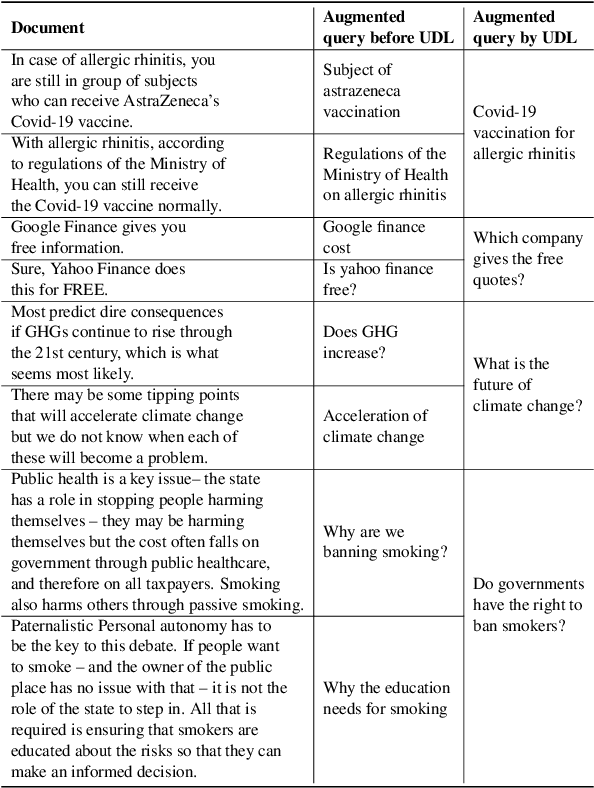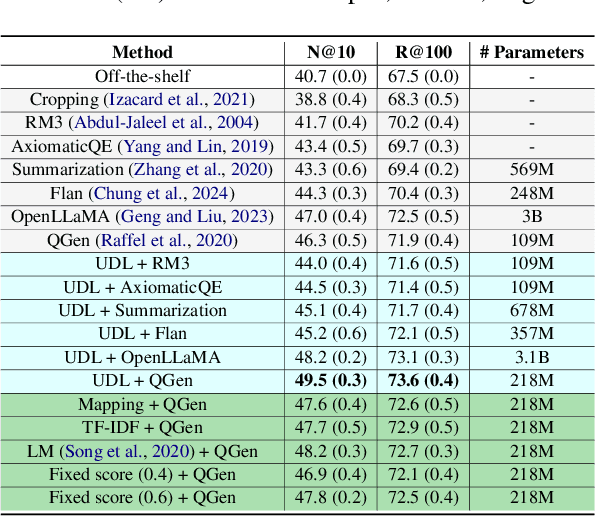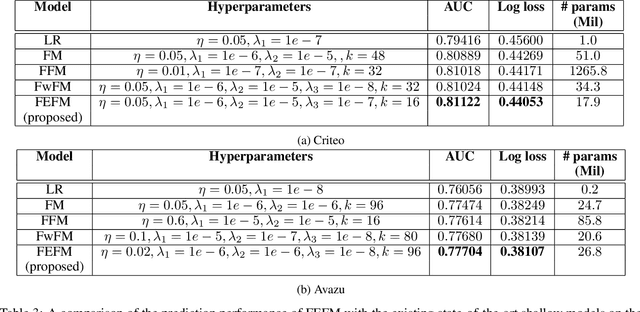Harshit Pande
Link, Synthesize, Retrieve: Universal Document Linking for Zero-Shot Information Retrieval
Oct 24, 2024



Abstract:Despite the recent advancements in information retrieval (IR), zero-shot IR remains a significant challenge, especially when dealing with new domains, languages, and newly-released use cases that lack historical query traffic from existing users. For such cases, it is common to use query augmentations followed by fine-tuning pre-trained models on the document data paired with synthetic queries. In this work, we propose a novel Universal Document Linking (UDL) algorithm, which links similar documents to enhance synthetic query generation across multiple datasets with different characteristics. UDL leverages entropy for the choice of similarity models and named entity recognition (NER) for the link decision of documents using similarity scores. Our empirical studies demonstrate the effectiveness and universality of the UDL across diverse datasets and IR models, surpassing state-of-the-art methods in zero-shot cases. The developed code for reproducibility is included in https://github.com/eoduself/UDL
Dynamic region proposal networks for semantic segmentation in automated glaucoma screening
May 19, 2021



Abstract:Screening for the diagnosis of glaucoma through a fundus image can be determined by the optic cup to disc diameter ratio (CDR), which requires the segmentation of the cup and disc regions. In this paper, we propose two novel approaches, namely Parameter-Shared Branched Network (PSBN) andWeak Region of Interest Model-based segmentation (WRoIM) to identify disc and cup boundaries. Unlike the previous approaches, the proposed methods are trained end-to-end through a single neural network architecture and use dynamic cropping instead of manual or traditional computer vision-based cropping. We are able to achieve similar performance as that of state-of-the-art approaches with less number of network parameters. Our experiments include comparison with different best known methods on publicly available Drishti-GS1 and RIM-ONE v3 datasets. With $7.8 \times 10^6$ parameters our approach achieves a Dice score of 0.96/0.89 for disc/cup segmentation on Drishti-GS1 data whereas the existing state-of-the-art approach uses $19.8\times 10^6$ parameters to achieve a dice score of 0.97/0.89.
Field-Embedded Factorization Machines for Click-through rate prediction
Sep 13, 2020



Abstract:Click-through rate (CTR) prediction models are common in many online applications such as digital advertising and recommender systems. Field-Aware Factorization Machine (FFM) and Field-weighted Factorization Machine (FwFM) are state-of-the-art among the shallow models for CTR prediction. Recently, many deep learning-based models have also been proposed. Among deeper models, DeepFM, xDeepFM, AutoInt+, and FiBiNet are state-of-the-art models. The deeper models combine a core architectural component, which learns explicit feature interactions, with a deep neural network (DNN) component. We propose a novel shallow Field-Embedded Factorization Machine (FEFM) and its deep counterpart Deep Field-Embedded Factorization Machine (DeepFEFM). FEFM learns symmetric matrix embeddings for each field pair along with the usual single vector embeddings for each feature. FEFM has significantly lower model complexity than FFM and roughly the same complexity as FwFM. FEFM also has insightful mathematical properties about important fields and field interactions. DeepFEFM combines the FEFM interaction vectors learned by the FEFM component with a DNN and is thus able to learn higher order interactions. We conducted comprehensive experiments over a wide range of hyperparameters on two large publicly available real-world datasets. When comparing test AUC and log loss, the results show that FEFM and DeepFEFM outperform the existing state-of-the-art shallow and deep models for CTR prediction tasks.
 Add to Chrome
Add to Chrome Add to Firefox
Add to Firefox Add to Edge
Add to Edge